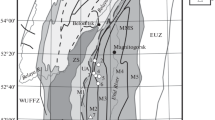Abstract
The REM(AF) method is a new tool for the analysis of the origin and alternating field demagnetization coercivity spectra of the remanent magnetization. We applied this method on precambrian Gila diabase sheets from Arizona in order to identify the high coercivity magnetic carrier, and on artificially shocked Rowley Regis basalt from UK in order to analyze the effect of the shock on the natural remanent magnetization.
In the Gila diabase the high coercivity magnetic component was identified to be most likely represented by the acicular magnetite (increase in the efficiency ratio in the high coercivity region).
In the Rowley Regis basalt, the REM(AF) analysis revealed that comparing to NRM, the shock produced a different distribution of the AF demagnetization coercivity spectra due to the occurrence of the Shock Remanent Magnetization.
Similar content being viewed by others
References
Cisowski S.M., Dunn J.R., Fuller M. and Wasilewski P.J., 1990. NRM:IRM(s) demagnetization plots of intrusive rocks and the origin of their NRM. Tectonophysics, 184, 35–54.
Cisowski S.M. and Fuller M., 1986. Lunar paleointensities via the IRMs normalization method and the early magnetic history of the Moon. In: Hartmann W.K., Phillips R.J. and Taylor G.J. (Eds.), Origin of the Moon. Lunar and Planetary Institute Houston, 411–424.
Day R., Fuller, M.D. and Schmidt V.A., 1977. Hysteresis properties of titano-magnetites: grain size and composition dependence. Phys. Earth Planet. Inter., 13, 260–266.
Dunlop D.J., 2002. Theory and application of the Day plot (Mrs/Ms versus Hcr/Hc). 2. Application to data for rocks, sediments and soils. J. Geophys. Res., 107, doi:10.1029/2001JB000487.
French B.M., 1998. Traces of Catastrophe: A Handbook of Shock-Metamorphic Effects in Terrestrial Meteorite Impact Structures. Technical Report, LPI-Contrib-954, Lunar and Planetary Institute, Houston, 120 pp.
Fuller M., Cisowski S., Hart M., Haston R. and Schmidtke E., 1988. NRM:IRM(s) demgnetization plots; an aid to the interpretation of natural remanent magnetization. Geophys. Res. Lett., 15, 518–521.
Fuller M., 1974. Lunar magnetism. Rev. Geophys., 12, 23–70.
Gattacceca J., Rochette P. and Denise M., 2003. Magnetic properties of a freshly fallen LL ordinary chondrite: the Bensour meteorite. Phys. Earth Planet. Inter., 140, 343–358.
Gattacceca J. and Rochette P., 2004. Toward a robust paleointensity estimate for meteorites. Earth Planet. Sci. Lett., 227, 377–393.
Jarrard R.D. and Cockerham R.S., 1975. Reliability of paleolatitudes from Pacific DSDP sediment cores. EOS Trans. Am. Geophys. Union, 56, 977–978.
Kletetschka G., Acuna M.H., Kohout T., Wasilewski P.J. and Connerney J.E.P., 2004. An empirical scaling law for acquisition of thermoremanent magnetization. Earth Planet. Sci. Lett., 226, 521–528.
Martelli G. and Newton G., 1977. Hypervelocity cratering and impact magnetization of basalt. Nature, 269, 478–480.
Melosh H.J., 1989. Impact Cratering: A Geologic Process. Oxford Monographs on Geology and Geophysics No.11, Oxford University Press, New York, Oxford, 245 pp.
Rochette P., Mathe P., Esteban L., Rakoto H., Bouchez J., Liu Q. and Torrent J., 2005. Nonsaturation of the defect moment of goethite and fine-grained hematite up to 57 Teslas. Geophys. Res. Lett., 32, doi: 10.1029/2005GL024196.
Srnka L.J., Martelli G., Newton G., Cisowski S.M., Fuller M. and Schaal R.B., 1979. Magnetic field and shock effects and remanent magnetization in a hypervelocity impact experiment. Earth Planet. Sci. Lett., 42, 127–137.
Verrier V. and Rochette P., 2002. Estimating peak currents at ground lightning impact using remanent magnetization. Geophys. Res. Let., 29, 10.1029/2002GL015207.
Yu Y.J. 2006. How accurately can NRM/SIRM determine the ancient planetary magnetic field intensity? Earth Planet. Sci. Lett., 250, 27–37.
Yu Y.J., Tauxe L. and Gee J.S., 2007. A linear field dependence of thermoremanence in low magnetic fields. Phys. Earth Planet. Inter., 162, 244–248.
Wasilewski P.J., 1977. Magnetic and microstructural properties of some lodestones. Phys. Earth Planet. Inter., 15, 349–362.
Author information
Authors and Affiliations
Corresponding author
Rights and permissions
About this article
Cite this article
Kohout, T., Kletetschka, G., Donadini, F. et al. Analysis of the natural remanent magnetization of rocks by measuring the efficiency ratio through alternating field demagnetization spectra. Stud Geophys Geod 52, 225–235 (2008). https://doi.org/10.1007/s11200-008-0015-1
Received:
Revised:
Accepted:
Published:
Issue Date:
DOI: https://doi.org/10.1007/s11200-008-0015-1




